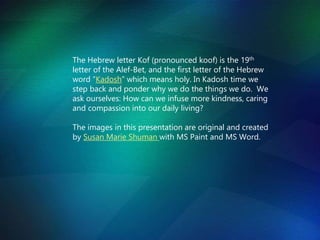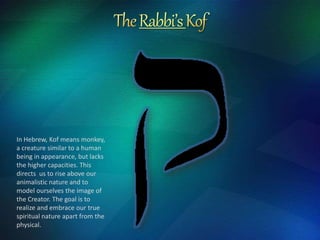The Art of Kof
- 2. The Hebrew letter Kof (pronounced koof) is the 19th letter of the Alef-Bet, and the first letter of the Hebrew word “Kadosh” which means holy. In Kadosh time we step back and ponder why we do the things we do. We ask ourselves: How can we infuse more kindness, caring and compassion into our daily living? The images in this presentation are original and created by Susan Marie Shuman with MS Paint and MS Word.
- 3. Rabbi’s In Hebrew, Kof means monkey, a creature similar to a human being in appearance, but lacks the higher capacities. This directs us to rise above our animalistic nature and to model ourselves the image of the Creator. The goal is to realize and embrace our true spiritual nature apart from the physical.
- 4. The Golden Kof The Kof is the only letter which extends below the line of the other letters, indicating descent into the lower world, but also the ability to ascend from there.
- 5. Kof symbolizes the cycles of nature, changing seasons, as well as the human life cycle. It is the constant movement, circulation, and change of life.
- 6. Rabbi Shlomo Itzkhaki, aka Rashi, was a notable commentator and prolific writer who created his own style of Hebrew script. Rashi’s script turned out to be a prototype to the modern Hebrew cursive
- 7. The bottom of the Kof is a person calling “Holy” (Kadosh) to become One with God. The top line, protecting and reaching down, is the Holy One.
- 8. Such is Kof. The voice by which we allow God to be present by saying, “Kadosh.” It is also the voice through which God asks us if we desire the Holy One’s presence.
- 9. Nothing can be Holy without the voice of Kof to say it is. As well, we, with our own voices, can make the entire world Holy. Kadosh.
- 10. The Phoenician Alphabet is the oldest substantiated alphabet. It is an abjad, meaning it is comprised of only consonants. Like Hebrew, there are twenty-two characters in this alphabet. Since there were no vowels, matres lectionis, (Mother of Reading) was implemented, which refers to the use of certain consonants to indicate a vowel. In Hebrew these letters are Hei, Vav, Yud and later, Alef.
- 11. Similar to the Phoenician Alphabet (above) that it replaced, the Paleo script was used by the Israelites around the 10th century BCE. It fell out of favor during the 5th century BCE when Aramaic became the preferred writing system for Hebrew scribes
- 12. There is a story behind this Kof. After creating it, I was unable to come up with a suitable name. So, Rabbi Fuchs and I decided to have a contest to Name That Kof. The winner was Akuokuo (KoKo) Vallis, who blogs over at https://stroked.live/
- 13. The following Kofs are inspired by my subconscious after compiling/editing Rabbi Fuchs’ book, Why the Kof? Getting the Best of Rabbi Fuchs. The more I learned about Kof, the more I wanted to learn. Creating them was a peaceful and almost surreal experience. Now, I cannot stop and am working my way through the rest of the Hebrew Alef-Bet. That gives me an idea! Have you ever created a Kof? You’ve got to try it! I would be interested to see your designs. So let’s have a contest! Submit your creations to me, Susan Marie Shuman, at susanwritesprecise@gmail.com (no limit on entrees) by October 4, Erev Sukkot. The artist of the Kof considered most inspiring by Rabbi Fuchs and me will receive a free signed copy of his forthcoming book, Why Triple Chai? More of the Best of Rabbi Fuchs. Happy ‘Koffing!’ The Rest of the Kofs
- 46. Available now at Amazon.com!














































